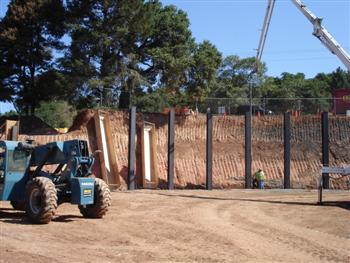WATER

Click thumbnail to enlarge
   |
Project:
Proctor Heights Water Storage Tanks
Client:
City of Santa Rosa
Faced with a growing population and uncertainty surrounding
future regional water resources, the City of Santa Rosa realized a
need for additional water storage in their aqueduct (lower) pressure
zone to improve system reliability and supplement emergency
reserves. Preliminary planning identified a City-owned parcel of
land, located in the Proctor Heights area of Santa Rosa, as a
potential site for new water tank construction.
The Proctor Heights tank site is located in a wooded
neighborhood, bordered on three sides by City streets and houses
on the fourth side. Inside the curve of a busy roadway and
highly visible, the tank design required special attention to
aesthetics and safety that otherwise would not have been an
issue.
Preliminary designs determined that two 2.6 MG tanks would
grant the largest possible volume of storage on the site; also
fulfilling the City’s desire to have twin tanks for reliability
purposes. Fitting two welded steel tanks on the relatively small
site required the use of a retaining wall ranging in height from
four to 22 feet and stretching around both tanks for a distance
of approximately 400 linear feet.
Modifications to piping in adjacent streets were also
designed, allowing water from a City-owned well to be pumped
directly into the new tanks. This allows the lower quality well
water to be blended with higher quality tank water rather than
being pumped directly into the distribution system. Brelje &
Race also recommended and designed a new pump station on the
site, which allows the City to send water directly from the new
tanks to the higher pressure zones above. This helps maintain
high water quality in the tanks during low demand periods, and
increases water supply reliability to the upper pressure zones.
|







